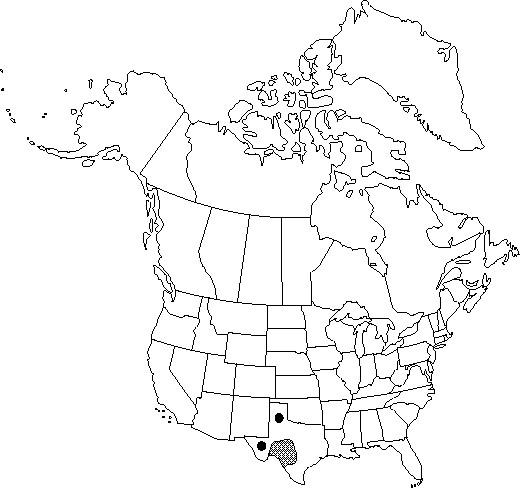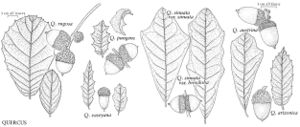Difference between revisions of "Quercus vaseyana"
Bull. Torrey Bot. Club 10: 91. 1883.
FNA>Volume Importer |
FNA>Volume Importer |
||
| Line 14: | Line 14: | ||
|basionyms= | |basionyms= | ||
|synonyms={{Treatment/ID/Synonym | |synonyms={{Treatment/ID/Synonym | ||
| − | |name= | + | |name=Quercus pungens var. vaseyana |
|authority=(Buckley) C. H. Muller | |authority=(Buckley) C. H. Muller | ||
| − | }}{{Treatment/ID/Synonym | + | }} {{Treatment/ID/Synonym |
| − | |name= | + | |name=Quercus undulata var. vaseyana |
|authority=(Buckley) Rydberg | |authority=(Buckley) Rydberg | ||
}} | }} | ||
| Line 34: | Line 34: | ||
|elevation=300-600 m | |elevation=300-600 m | ||
|distribution=Tex.;Mexico (Chihuahua;Coahuila;and Nuevo León). | |distribution=Tex.;Mexico (Chihuahua;Coahuila;and Nuevo León). | ||
| − | |discussion=<p>Apparent hybridization between Quercus vaseyana and Q. pungens is discussed under the latter species.</p> | + | |discussion=<p>Apparent hybridization between <i>Quercus vaseyana</i> and <i>Q. pungens</i> is discussed under the latter species.</p> |
|tables= | |tables= | ||
|references= | |references= | ||
| Line 47: | Line 47: | ||
|rank=species | |rank=species | ||
|parent rank=section | |parent rank=section | ||
| − | |synonyms= | + | |synonyms=Quercus pungens var. vaseyana;Quercus undulata var. vaseyana |
|basionyms= | |basionyms= | ||
|family=Fagaceae | |family=Fagaceae | ||
| Line 58: | Line 58: | ||
|publication year=1883 | |publication year=1883 | ||
|special status=Selected by author to be illustrated | |special status=Selected by author to be illustrated | ||
| − | |source xml=https://jpend@bitbucket.org/aafc-mbb/fna-data-curation.git/src/ | + | |source xml=https://jpend@bitbucket.org/aafc-mbb/fna-data-curation.git/src/8f726806613d60c220dc4493de13607dd3150896/coarse_grained_fna_xml/V3/V3_263.xml |
|genus=Quercus | |genus=Quercus | ||
|section=Quercus sect. Quercus | |section=Quercus sect. Quercus | ||
Revision as of 17:15, 18 September 2019
Shrubs or small trees, evergreen or subevergreen, to 10 m. Bark dark brown, furrowed and exfoliating in long strips. Twigs reddish or grayish brown, 1-1.5 mm diam., short stellate-tomentose or tomentulose, later glabrate or persistently pubescent, rarely glabrous. Buds dark red-brown or gray, round-ovoid, 1-1.5 mm, apex obtuse, sparsely pubescent or glabrate. Leaves: petiole to 5 mm. Leaf blade narrowly lanceolate to usually oblong, mostly planar or slightly convex, 20-60(-90) × 10-20 mm, often rather leathery, base cuneate to rounded, margins coarsely 3-5-toothed on each side or shallowly lobed or entire, with teeth or lobes acute or obtuse, mucronate-tipped, secondary veins 4-6 on each side, usually branched, apex acute, rarely obtuse; surfaces abaxially densely stellate with minute appressed hairs, rarely glabrate and lustrous green, adaxially dark green, lustrous, glabrous or very sparsely stellate-puberulent. Acorns subsessile or on peduncle 2-3 mm; cup saucer-shaped to cup-shaped, 3-4 mm deep × 10 mm wide, margin thin, scales reddish brown, strongly, regularly tuberculate; nut light brown, ovoid to oblong or subcylindric, to 12 × 12 mm, glabrous. Cotyledons distinct.
Phenology: Flowering spring.
Habitat: Dry limestone slopes, oak and mesquite woodlands, juniper woodlands, and canyons and ravines in otherwise dry, open grasslands, sometimes descending into margins of dry scrub
Elevation: 300-600 m
Distribution

Tex., Mexico (Chihuahua, Coahuila, and Nuevo León).
Discussion
Apparent hybridization between Quercus vaseyana and Q. pungens is discussed under the latter species.
Selected References
None.
